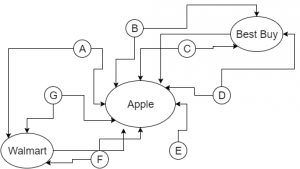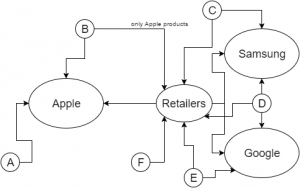Apple’s Network Power
Apple has built a reputation for selling high-quality devices at a high price point. It is able to do this because it has adopted a very precise marketing strategy. Former CEO Steve Jobs cited four pillars:
- Offer a small number of products.
- Focus on the high end
- Give priority to profits over market share
- Create a halo effect that makes people starve for new Apple products
By following these guidelines, Apple had become the powerhouse in the tech industry. It has created a system that generates a huge amount of customer loyalty and also gives them a fair amount of freedom when it comes to pricing. They have achieved this through product differentiation (Nielson). This situation can be idealized as network bargaining.
If we imagine Apple as a seller and all people who want to buy smartphones as buyers, we can d escribe the situation as one where Apple has a lot of power. If we first simplify things and say that Apple has no competitors, then each buyer can form links only with Apple and have no alternate options, which gives Apple a lot of power within the network. Because each buyer has no other potential supplier, the only balanced outcome is when it receives all of the payoff from each link and the buyers receive none, so it has the power to control price. However, not all buyers will purchase directly from Apple, Some will go through third-party retailers like Best Buy and Wal-Mart to make their purchases. In situations like this, Apple wants to maintain it’s power in the market, and has therefore set systems in place to prevent these retailers from powerful outside options. By using a retail strategy called “minimum advertising price” (Nielson). This strategy essentially prevents retailers from selling below some minimum prices. Furthermore, Apple wholesale discount to retailers is small, so retailers must price Apple’s products near the suggested retail price in order to profit on the device (Nielson). The result
escribe the situation as one where Apple has a lot of power. If we first simplify things and say that Apple has no competitors, then each buyer can form links only with Apple and have no alternate options, which gives Apple a lot of power within the network. Because each buyer has no other potential supplier, the only balanced outcome is when it receives all of the payoff from each link and the buyers receive none, so it has the power to control price. However, not all buyers will purchase directly from Apple, Some will go through third-party retailers like Best Buy and Wal-Mart to make their purchases. In situations like this, Apple wants to maintain it’s power in the market, and has therefore set systems in place to prevent these retailers from powerful outside options. By using a retail strategy called “minimum advertising price” (Nielson). This strategy essentially prevents retailers from selling below some minimum prices. Furthermore, Apple wholesale discount to retailers is small, so retailers must price Apple’s products near the suggested retail price in order to profit on the device (Nielson). The result  of these strategies is that the outside options for buyers are not actually any better than Apple. In addition, the retailers end up with very little payoff because of the tight margins that Apple enforces. This is represented in the network by the fact that like buyers in the simplified situation, retailers can turn only to Apple for product.
of these strategies is that the outside options for buyers are not actually any better than Apple. In addition, the retailers end up with very little payoff because of the tight margins that Apple enforces. This is represented in the network by the fact that like buyers in the simplified situation, retailers can turn only to Apple for product.
Finally, Apple must also compete with other producers for a buyers business. This is where there product differentiation really comes into play. By having a track record of high-quality products that have powerful hardware and user-friendly software, Apple has created a very loyal customer base, who will refuse to turn to other companies for smartphones and other technology. In a network representation, this means that many buyers simply will not have links to other manufacturers, and therefore will not enter transactions with other potential suppliers. This means that they continue to have power in the market because buyers still have no outside options, which means that Apple will contin ue to have network control over its buyers, and be able to continue charging premium prices for their products.
ue to have network control over its buyers, and be able to continue charging premium prices for their products.
